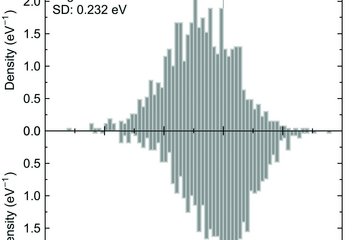All genres
301.
Journal Article
Ab initio up to the melting point: Anharmonicity and vacancies in aluminum. Physical Review B 79 (13), 134106 (2009)
302.
Journal Article
Understanding the phase transformations of the Ni2MnGa shape memory system from first principles. Physical Review Letters 102 (3), 035702 (2009)
303.
Journal Article
Fully ab initio finite-size corrections for charged defect supercell calculations. Physical Review Letters 102 (1), 016402 (2009)
304.
Journal Article
Using ab initio calculations in designing bcc Mg-Li alloys for ultra light-weight applications. Acta Materialia 57 (1), pp. 69 - 76 (2009)
305.
Journal Article
Steel design from fully parameter-free ab initio computer simulations. Steel Research International 80, pp. 4 - 8 (2009)
306.
Journal Article
Atomistic calculations on interfaces: Bridging the length and time scales. The European Physics Journal Special Topics 177, pp. 41 - 57 (2009)
307.
Journal Article
Multiscale simulation of polycrystal mechanics of textured β-Ti alloys using ab initio and crystal-based finite element methods. Physica Status Solidi B 245 (12), pp. 2642 - 2648 (2008)
308.
Journal Article
A comparison of atomistic and continuum theoretical approaches to determine electronic properties of GaN/AlN quantum dots. Physical Review B 78, 235302 (2008)
309.
Journal Article
A map for phase-change materials. Nature Materials 7, pp. 972 - 977 (2008)
310.
Journal Article
Error-propagation in multiscale approaches to the elasticity of polycrystals. Physica Status Solidi (B) 245, pp. 2636 - 2641 (2008)
311.
Journal Article
Free energy of bcc iron: Integrated ab initio derivation of vibrational, electronic, and magnetic contributions. Physical Review B 78, 033102 (2008)
312.
Journal Article
First principles free energy analysis of helix stability: The origin of the low entropy in pi-helices. Journal of Physical Chemistry B 112, pp. 4109 - 4112 (2008)
313.
Journal Article
Consistent set of band parameters for the group-III nitrides AlN, GaN, and InN. Physical Review B 77, 075202 (2008)
314.
Journal Article
Exciting prospects for solids: Exact-exchange based functionals meet quasiparticle energy. Physica Status Solidi (B) 245 (5), pp. 929 - 945 (2008)
315.
Journal Article
A comparison of polycrystalline elastic constants computed by analytic homogenization schemes and FEM. Physica Status Solidi B 245, pp. 2630 - 2635 (2008)
316.
Journal Article
Compositional Correlation and Anticorrelation in Quaternary Alloys: Competition Between Bulk Thermodynamics and Surface Kinetics. Physical Review Letters 99 (20), 206103 (2007)
317.
Journal Article
Theory-guided bottom-up design of β-titanium alloys as biomaterials based on first principles calculations: Theory and experiments. Acta Materialia 55 (13), pp. 4475 - 4487 (2007)
318.
Journal Article
Ab initio study of the thermodynamic properties of nonmagnetic elementary fcc metals: Exchange-correlation-related error bars and chemical trends. Physical Review B 76 (2), 024309 (2007)
319.
Journal Article
First-principles calculations of the structural and electronic properties of clean GaN (0001) surfaces. Physical Review B 73 (20), pp. 205346-1 - 205346-13 (2006)
320.
Journal Article
Bulk Electronic Structure of Metals Resolved with Scanning Tunneling Microscopy. Physical Review Letters 96, pp. 046801-1 - 046801-4 (2006)











